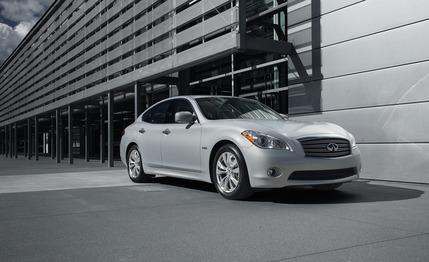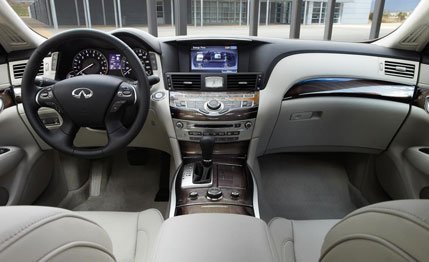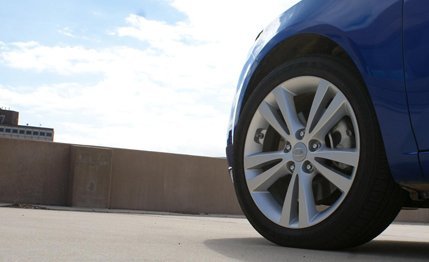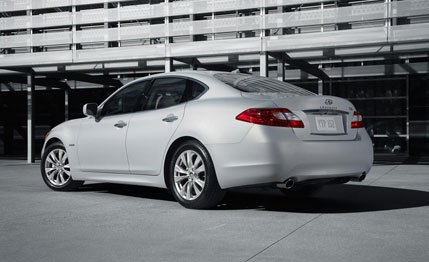
 Short Take Road Test
Short Take Road Test


Blindfold us and put us behind the wheel of any car—preferably not in heavy traffic—and we would probably be able to correctly identify Infinitis with more success than any other make. From the throttle to the brakes to the steering, the major controls in vehicles from Nissan’s luxury division are remarkably consistent. Unfortunately, those controls are consistently too hair-trigger quick to achieve perfection, the throttles overly snappy, the brakes too grabby, and the steering too twitchy for the sort of relaxed driving we don’t do often but a well-balanced car should be capable of.
Regardless of manufacturer, many hybrid vehicles also enjoy a rare commonality of feel. Aside from the obvious defining characteristic—the stopping and starting of the engine—the electric power-steering systems fitted to hybrids typically deprive the driver of any communication through the wheel, and regenerative braking systems frequently turn brake pedals to nonlinear mush. In the Infiniti M35h, which pairs a 302-hp version of Infiniti’s 3.5-liter V-6 with a 67-hp electric motor—those two opposing extremes cancel each other out beautifully, lending the M35h a more refined personality than the rest of the M lineup.
Take It Easy
Even though the hybrid has the same steering ratio as do other rear-wheel-drive Ms and the electrohydraulic boost still demands a fair bit of effort, its weighting is nowhere near as aggressive, and the on-center response is dulled just the right amount from the M’s usual sneeze-into-the-median twitchiness. Infiniti fits uniquely tuned shocks and anti-roll bars to the hybrid, and the 245/50-18 Michelins have a touch more sidewall than the tires on most of the Ms we drive, giving the hybrid an ever-so-slightly calmer ride than the rest of the family.


Although the hybrid’s 1.4-kilowatt-hour lithium-ion battery, electric motor, and ancillary systems add weight, where that weight goes is actually beneficial to the M. Infiniti claims a weight gain of 276 pounds over the M37, but our scales pegged the hybrid at 164 pounds heavier than the last V-6 M we tested, with 153 of those extra pounds over the rear axle. That shifts the hybrid’s weight distribution rearward so it carries 51 percent over the front wheels versus that last M37’s 53. This makes for much more neutral cornering behavior, with a whiff of understeer that’s easily dialed out with the throttle—although, just like on other Ms, the hybrid’s stability-control system can’t be defeated and limited our skidpad fun to 0.83 g.
It’s the same story with the hybrid’s brakes, which go beyond the regenerative function typical of hybrid vehicles and use an electric motor to generate the hydraulic pressure used to pinch the rotors and slow the car. The M37 and M56’s brakes are so touchy that a particularly large horsefly landing on the pedal will have you wiping snot marks from the windshield. The hybrid’s stop pedal still feels firm, but smooth application and fine modulation are infinitely easier. The M35h did need 14 more feet to stop from 70 mph than the last M37 we tested, though.
Look to the Germans
There is, however, room for improvement in the hybrid system’s integration. Infiniti’s approach is similar to that employed successfully by Porsche and Volkswagen, putting the electric motor between the engine and its seven-speed automatic transmission. The difference is that, whereas the Germans retain their torque converters, the Infiniti’s electric motor is separated from the engine by a clutch. A second clutch aft of the transmission allows some slip to smooth the transition from electric to gas-powered locomotion. According to the EPA, this process increases urban fuel economy 50 percent, with the M35h earning a rating of 27 mpg compared with the M37’s 18. There’s a significant boost on the highway, too, with the hybrid rated at 32 mpg compared with the M37’s 26. Amazingly, we recorded 26 mpg over nearly 1000 miles with the M35h, with a couple of tankfuls cresting 30 mpg.
At highway speeds—the engine can shut down at speeds up to 85 or so mph—the comings and goings of internal combustion are barely noticeable, but the process calls more attention to itself the slower the M35h is traveling. From a stop, we found it difficult to get a smooth launch regardless of how gentle our throttle inputs were—those who accelerate slowly enough to stay on electric power alone deserve the box truck that will inevitably find its way into their back seat. Once under way, the engine shuts down seamlessly but refires and rejoins the propulsion process abruptly, with nearly every throttle application resulting in an embarrassing jolt. That clutch behind the transmission needs more massaging.


The other major drawback of the hybrid M is trunk space. The battery pack resides behind the rear seatbacks and consumes four of the regular M’s 15 cubic feet of trunk space. That doesn’t seem like a terrible amount, but the remaining cavity is surprisingly truncated, the front wall seemingly right below the leading edge of the trunk opening. Be sure to buy exclusively cubic objects measuring no more than 18 inches in any dimension.
Infiniti’s gas-electric swinger does, however, make a compelling case for performance hybrids. The combined powertrain output is 360 hp, and the electric motor’s 199 lb-ft of torque help sling the M35h to 60 mph in 5.2 seconds, bettering the nonhybrid M37 by 0.3 second. Through the quarter-mile, the hybrid leads its gas-only stablemate by 0.1 second and 2 mph, at 13.9 and 103.
Celebrate Conservation with Consumption
Compared with the M37, the M35h will hinder your purchasing power by an extra $6000. Unlike hybrid versions of many other vehicles, that premium nets the M buyer precisely no extra stuff aside from the hybrid systems. And the extra power. Buyers who want more power than the M37 but don’t want to belly up to the $59,995 M56 will save $5400 by opting for the hybrid. Well, and the hybrid is fitted with the least-imaginative “hybrid” badges ever affixed to a vehicle’s front fenders. Floating alone in the middle of those fenders, Infiniti’s usually elegant signature script looks like a placeholder font that carried into production when nobody bothered to design something better.
From its $54,595 starting price, the car tested here rose to $61,745 on the merits of the $3350 Premium package and the $3800 Deluxe Touring package. The former adds navigation, satellite radio, a 10-speaker Bose stereo, heated and cooled front seats, and a heated steering wheel; the latter brings another six speakers plus 5.1-channel surround, a power rear sunshade, quilted leather seats, white ash wood trim, a faux-suede headliner, and a leather-wrapped hood for the instrumentation.
Given the hybrid’s fuel-economy estimates, you’d need—actually, who cares how unrealistically long an owner would have to keep the M35h hybrid to recoup the premium? That’s not the point of any hybrid, nor is it the point of this one. The added cost and the low return on investment usually have us asking, “What’s the point?” But with the M35h, the point, and the reward, are clear: the smoothest, most relaxed M available, and a quick one to boot.

